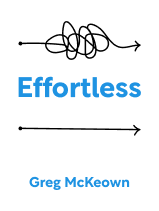

This article is an excerpt from the Shortform book guide to "Effortless" by Greg McKeown. Shortform has the world's best summaries and analyses of books you should be reading.
Like this article? Sign up for a free trial here.
Is hard work really the key to success? What if we instead found easier routes to progress and success and integrated them into our lives?
In our professional and personal lives, we’re often taught that to achieve progress, we must work as hard as we possibly can. According to Greg McKeown, it doesn’t have to be that way. In his book Effortless, he debunks this belief and suggests several ways to make the most of your time with less effort.
Here’s how to make progress effortlessly, according to Greg McKeown.
Know When You’re Finished
If you want to know how to make progress without much effort, here’s advice from Effortless by Greg Mckeown. According to McKeown, before beginning a project you must clearly define at what stage it will be complete. This may seem obvious, but it’s a step people often overlook, which costs them more time and energy later. This is because, at a certain point, the more you work on something, the less you get done—what economists call the law of diminishing returns. To avoid this, your definition of “done” should be set at the point just before the law of diminishing returns sets in. For example, if you’re working on a business presentation, tell yourself it’s completed when the vital material is portrayed clearly and concisely, without adding too many pictures or superfluous information.
(Shortform note: In Getting Things Done, David Allen agrees with McKeown that envisioning the outcome of a project will help you achieve it, but he also recommends you first define your purpose in completing it. This is because knowing your purpose can help you find your definition of done: If you don’t know why you’re doing something, it will be much harder to know what you need to do. Additionally, knowing your purpose can also help you determine what tasks are most important and provide motivation and clarity to your project.)
Take the First Step
Once you’ve defined what finished looks like, McKeown advises taking the first step immediately. Many people are slow to get started on an important project because it feels overwhelming. You can avoid this feeling by taking the tiniest step you can take to begin. For example, if you need to read and respond to work-related emails, the first step isn’t reading the emails—it’s simply sitting in front of your computer. Once you take that tiny first step, the momentum builds from there.
(Shortform note: For more advice on how to take the first step, we can look to James Clear’s Atomic Habits. He recommends using the two-minute rule. Instead of committing to an entire activity, commit to the first two minutes to get the ball rolling. After that, continue breaking down the activity into two-minute increments. If you break an effortful activity into two-minute chunks, the perceived effort becomes much more palatable, thus increasing the likelihood you continue the activity.)
Embrace Mistakes
Another common trait people share is perfectionism—being too self-critical. This, according to McKeown, prevents effortless progress. If you try to get everything right the first time, you accomplish very little. Instead, by simply starting a project, embracing the mistakes, and fixing them quickly, you’re much more productive. To be less demanding of yourself, do the following:
- Be kind to yourself: Instead of criticizing yourself for failures or mistakes, commend yourself for your accomplishments.
- Lower your expectations: When working on a project or task, have the courage to begin without worrying about how bad it is.
Remove Unnecessary Steps
A key tenet of Effortless is to make things as simple as possible. McKeown recommends simplifying the work process by determining the most essential steps and removing the rest. Usually, in our attempt to make things easier, we simplify existing steps in a process. A more effective route is to remove steps entirely. To do this, determine the smallest amount of steps it would take to get to your desired outcome, and only perform tasks that add significant value.
Say you’re a journalist assigned to report on the public’s reaction to a new apartment complex. You may be tempted to interview dozens of people, make a detailed case for the pros and cons of the project, and look at the story from every conceivable angle. Instead, you take McKeown’s approach. You ask yourself what’s most important, and determine that the main things people care about are how much the project will cost and the benefits it will bring to the city. So you remove any steps that don’t support those two angles. It may not be the most masterful story, but it gets the job done. Most importantly, you expended minimal time and effort.
Pace Yourself
McKeown claims that finding the right pace of work is essential to making effortless progress. If you work too quickly or too much early on, you’ll inevitably hit a point where you can’t keep the momentum going. If you work too little, you may lose the motivation to continue. The goal, then, is to find the ideal range of effort to put in each day.
Finding this range will take trial and error, but the key is to determine the minimum and maximum amount of daily effort that works best for you. The minimum should be easily achievable but enough to constitute progress, and the maximum should be the most you feel you can do on a daily basis without getting exhausted. Having a limit on daily effort can sometimes seem counterintuitive, as you may feel that when you’re on a roll, you should keep going. But doing so can lead to a habit of overexertion and underachievement. No matter the task, find that sweet spot of productivity and stick to it.
| How to Make Progress Effortless Ultimately, McKeown’s idea of effortless progress is not about finding a way to work without effort, but finding a way to make effort feel easy. In Flow, Mihaly Csikszentmihalyi recommends a similar approach, advising that people try to achieve what he calls a “flow state.” People experience a flow state when they feel in control of their thoughts and feelings and voluntarily work hard to achieve something they deem important. Csikszentmihalyi argues that experiencing a flow state is a key to happiness because it’s in this state that we can find joy and purpose simultaneously. There are many similarities between McKeown’s effortless state and Csikszentmihalyi’s flow state, but the most important takeaway from both is that we can learn to direct our attention and limit distractions in ways that make us happier and more productive. |

———End of Preview———
Like what you just read? Read the rest of the world's best book summary and analysis of Greg McKeown's "Effortless" at Shortform.
Here's what you'll find in our full Effortless summary:
- Why you don't need to hustle and burn out to achieve your goals
- Why the easiest path to success is the most viable
- Actionable advice for how to achieve effortless success in life






